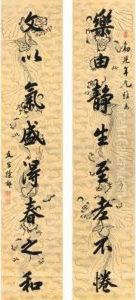Xu Fu Paintings
Xu Fu, also known as Jofuku in Japan, was a Chinese alchemist and explorer who lived during the Qin Dynasty (221-206 BCE). He is a legendary figure and not a traditional artist in the sense of creating visual artworks, so his biography does not follow the typical narrative of an artist's life and career. However, Xu Fu has been an influential character in Chinese and Japanese culture, often depicted in various forms of art over the centuries.
According to historical records, Xu Fu served as a court sorcerer for Qin Shi Huang, the first Emperor of a unified China. The Emperor was obsessed with finding the elixir of life that would grant him immortality. To fulfill the Emperor's quest, Xu Fu was dispatched on two major maritime expeditions to the mythical Penglai Mountain, where it was believed the immortals lived and where he hoped to find the elixir.
The first expedition took place around 219 BCE, when Xu Fu set sail with a fleet of ships and several thousand men and women. He returned without the elixir, claiming that a sea monster had blocked his path. Qin Shi Huang then provided him with archers to kill the creature, and Xu Fu embarked on a second expedition. He never returned to China, and there are various theories about his fate. Some suggest he settled in Japan and that his knowledge influenced the development of early Japanese society.
Xu Fu's historical existence is debated among scholars, and his life is shrouded in myth and legend. He has been portrayed in numerous Chinese and Japanese literary works, and his voyages have been depicted in paintings and sculptures. His story has also inspired modern artistic representations, including films, novels, and manga.
The lack of concrete evidence about Xu Fu's life after his departure on the second expedition means that his date of death remains unknown. However, his legendary status has endured for over two millennia, and he remains an intriguing figure in the cultural history of East Asia. In Japan, there are shrines dedicated to Xu Fu, where he is worshipped as a god of agriculture and medicine. His influence on the narrative arts and his incorporation into various cultural expressions solidify his place in the annals of historical figures who have sparked the collective imagination of artists and storytellers.
